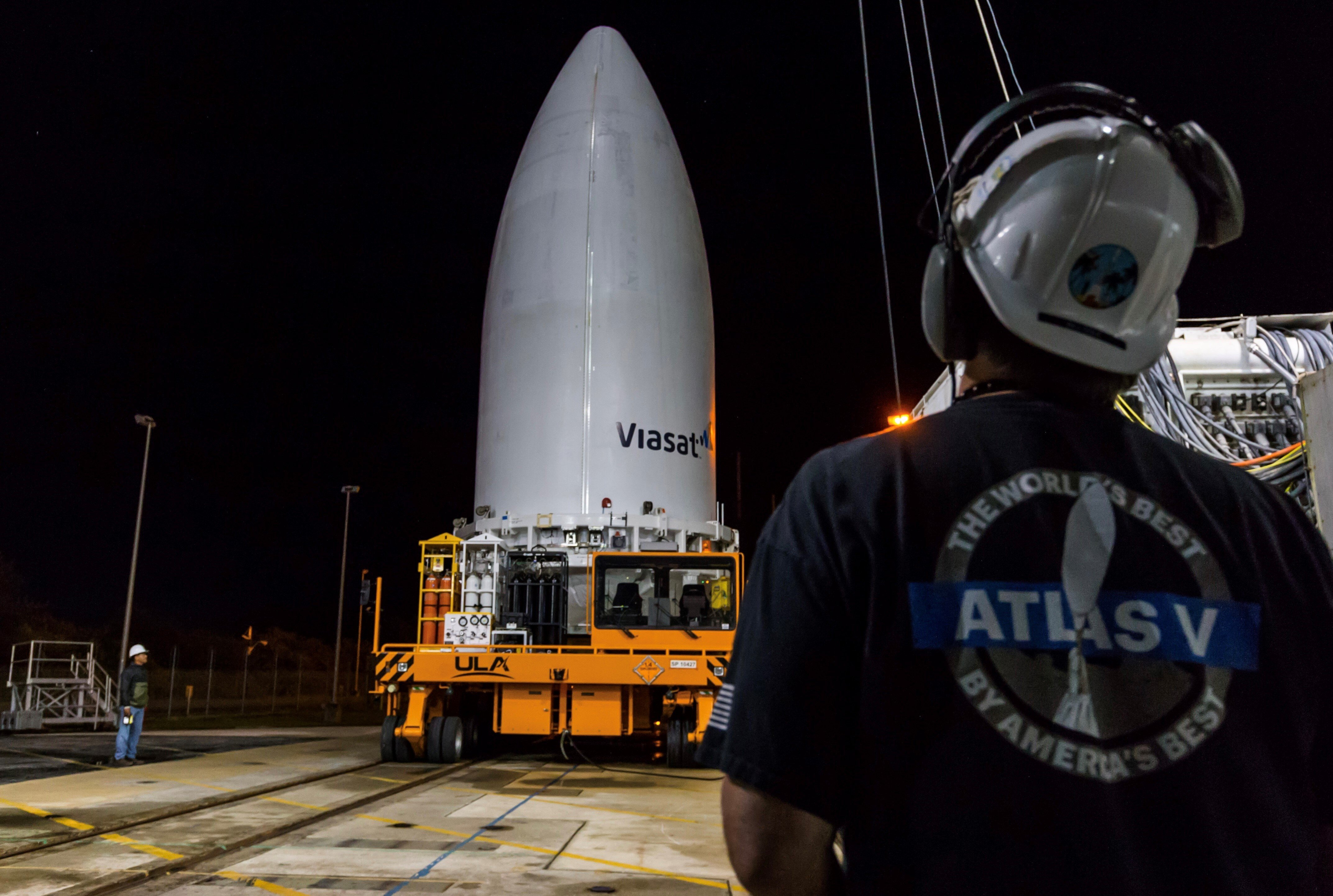
A commercial United Launch Alliance (ULA) Atlas V rocket will launch the ViaSat-3 Flight 2 (F2) ultra-high-capacity broadband satellite, designed to be capable of transmitting throughput in excess of one Terabit of data per second (1 Tbps) to users on land, at sea or in the air.
Launch is planned for Nov. 5 from Space Launch Complex-41 at Cape Canaveral Space Force Station, Florida, during a 44-minute launch window that opens at 10:24 p.m. EST (0324 UTC Nov. 6). ULA is performing the launch for Viasat, a global technology company helping businesses, governments and communities transform their world through connectivity. %20tall.%20Photo%20by%20United%20Launch%20Alliance.jpeg?width=230&height=345&name=the%20Atlas%20V%20551%20rocket%20with%20ViaSat-3%20F2%20stands%20196%20feet%20(59.7%20m)%20tall.%20Photo%20by%20United%20Launch%20Alliance.jpeg) ViaSat-3 F2 is expected to be one of the most sophisticated and powerful communications satellites ever deployed. It is considered an engineering marvel.
ViaSat-3 F2 is expected to be one of the most sophisticated and powerful communications satellites ever deployed. It is considered an engineering marvel.
From its operational vantage point in geostationary orbit approximately 22,000 miles (35,000 km) above Earth, ViaSat-3 F2 is designed to expand and enhance in-flight connectivity for commercial and business aviation passengers; exceed performance, security and resiliency for governments; enhance the ‘office-like’ and ‘home-like’ internet experience onboard vessels; and help deliver fast, reliable internet to more homes and small businesses in rural communities.
Viasat designed and manufactured the state-of-the-art Ka-band payload for receiving, transmitting and processing broadband internet data to and from the satellite. The payload module was then integrated onto a 702MP+ platform built by Boeing Satellite Systems in El Segundo, California. The spacecraft is equipped with eight solar panels, which are designed to unfold in orbit to generate over 25kW of power. The mission life is expected to be at least 15 years.
The enormous capacity boost from ViaSat-3 F2 is expected to provide more than double the bandwidth of Viasat’s existing satellite fleet – a fleet that is secure, reliable and highly flexible.
The satellite‘s anticipated throughput capacity of more than 1Tbps is equivalent to transmitting the contents of a two-mile-tall (3.2km) stack of books every second.
To get the highest productivity from the satellite, the agile ViaSat-3 F2 is designed with dynamic beam forming capabilities to move capacity to where the demand is, providing greater bandwidth to congested areas — even as demand changes throughout the day. This highly flexible capacity is enhanced by 1,000+ steerable spot beams that offer reliable connectivity for mobile platforms.

Preparations for this launch began Oct. 8 with achieving the Launch Vehicle on Stand (LVOS) milestone to place the Atlas V first stage aboard its mobile launch platform (MLP) at the Vertical Integration Facility (VIF). That was followed in subsequent days by adding five side-mounted solid rocket boosters (SRBs) and single-engine Centaur upper stage.
Encapsulated within a composite payload fairing, the satellite was hoisted atop the rocket on Oct. 28, completing another Atlas V 551 launch vehicle.
The Atlas V 551 rocket, the high-performance variant of the legendary rocket family, will utilize several launch optimization features to place the spacecraft into the best possible geosynchronous transfer orbit (GTO) for the spacecraft, which will weigh more than 13,000 pounds (6 metric tons) at launch.
ULA’s highly efficient Centaur upper stage will complete three firings of its RL10 main engine, increasing the transfer orbit altitude and, most notably, reducing the orbital inclination relative to the equator. What’s more, the third and final burn will employ the Minimum Residual Shutdown (MRS) sequencing, meaning Centaur will consume every last bit of cryogenic propellant to impart the maximum velocity available. This will result in minimizing the propellant and time that ViaSat-3 F2 will need to reach its final orbit.

This particular Atlas V 551 rocket, designated AV-100, stands 196 feet (59.7 meters) tall and will weigh 1.3 million pounds (587,000 kg) when fully fueled at liftoff. It will ascend from Florida’s Space Coast and head easterly on 2.7 million pounds (12 megaNewtons) of thrust from its kerosene-fueled main engine and SRBs.
The satellite is protected during the three minutes of atmospheric flight by a 68-foot-long (20.7-meter-), 17.7-foot-diameter (5.4-m-) composite payload fairing that jettisons once over the threshold of space.
The first Centaur burn achieves a low-altitude parking orbit around Earth; the second burn lifts the orbit to a highly elliptical one; and the final push occurs at apogee to raise perigee and move closer to the equator where the satellite is expected to eventually reside.
Release of ViaSat-3 from Atlas V is expected three hours and 32 minutes after liftoff. The free-flying satellite is due to complete its climb to a circular geostationary orbit, where it is anticipated to match Earth’s rotation and appear “parked” over the Americas, using its all-electric propulsion.
For more than 23 years, Atlas V has delivered launch success for an eclectic mix of national security, exploration, science and commercial endeavors. The 551 rocket configuration, like the one ViaSat-3 is using, has even launched missions to Jupiter and Pluto.
Learn more about the Atlas V ViaSat-3 F2 launch
See our ViaSat-3 F2 photo album

 Back To Blog List
Back To Blog List



